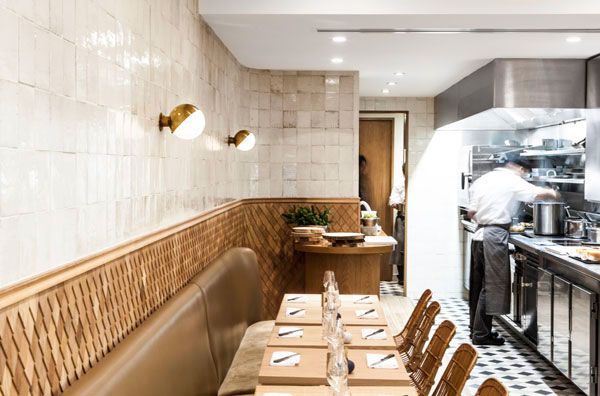
Young French architect Charlotte Biltgen has just created the intimate, pure and authentic Clover, an exciting new address in St-Germain-des-Prés for the chef Jean-François Piège.
Story continues below advertisement
The restaurant is the epitome of simple cooking: 50 m2 encompassing 20 covers, as well as a piano for the chef and his assistants. Preparation and tasting takes place seamlessly, directly with the product and the Michelin-starred chef’s team. It is, in the most literal sense, a dining room.
Story continues below advertisement
Clover for good luck and happiness, Charlotte Biltgen, Jean-François Piège and his wife Elodie initially tried their hand at finding objects by chance at the Puces de St Ouen and bric-a-brac shops in Brussels. A series of spherical Radiohuset wall lamps (1931) by the Danish architect Vilhem Lauritzen, some of the delightfully colourful crockery or the bistro table legs have therefore experienced a decorative history before becoming acquainted with Clover.
Story continues below advertisement
Likewise for the parquet, taken from SNCF freight wagons before being reconditioned for more of a gastronomic journey. The rough and solid floor subtly draws your gaze to the walls that also demonstrate an eye for detail and the disparity between the young interior designer’s favourite references.
Cracked after firing – what could be more befitting for a culinary setting, raku covers the walls with a layer of parchment-like and enticing ceramic like a crust of bread. This Japanese terracotta initially intended for crockery and home accessories has found new character as a tile well shaped by heat.
The cracks achieved through heating are the motif. A random and marvellous motif that Charlotte Biltgen devised (laid out) in her studio over four days so that the tiles complement each other. Attention to detail in extreme measures…
Raw ceramic interlacing that the architect decided to define with a shingle frieze, the American shingle tiles used to cover houses, like a material for exteriors that sweeps a scaly vegetal layer across the ever-smouldering raku. Solid wood is in evidence here again, with the rattan chairs and the table decor comprising natural branches to flank the delicate custom-made crockery and Swedish stem vases such as a small ceramic calabash.
The huge fridge facing the customers or guests, displays the fresh produce daily whilst two bespoke wardrobes accommodate the crockery, cutlery and accessories. Inspired by Portuguese glazed tiles, they are covered with deliberately unsaturated tiles. “The colour in on the plate, we didn’t want the setting to detract from the principle: Jean-François Piège’s authentic cooking conceived for this simple, almost homely eating place,” summarises Charlotte Biltgen.
Photography by Felipe Ribon
Clover
5 rue Perronnet
75007 Paris
Charlotte Biltgen
charlottebiltgen.com